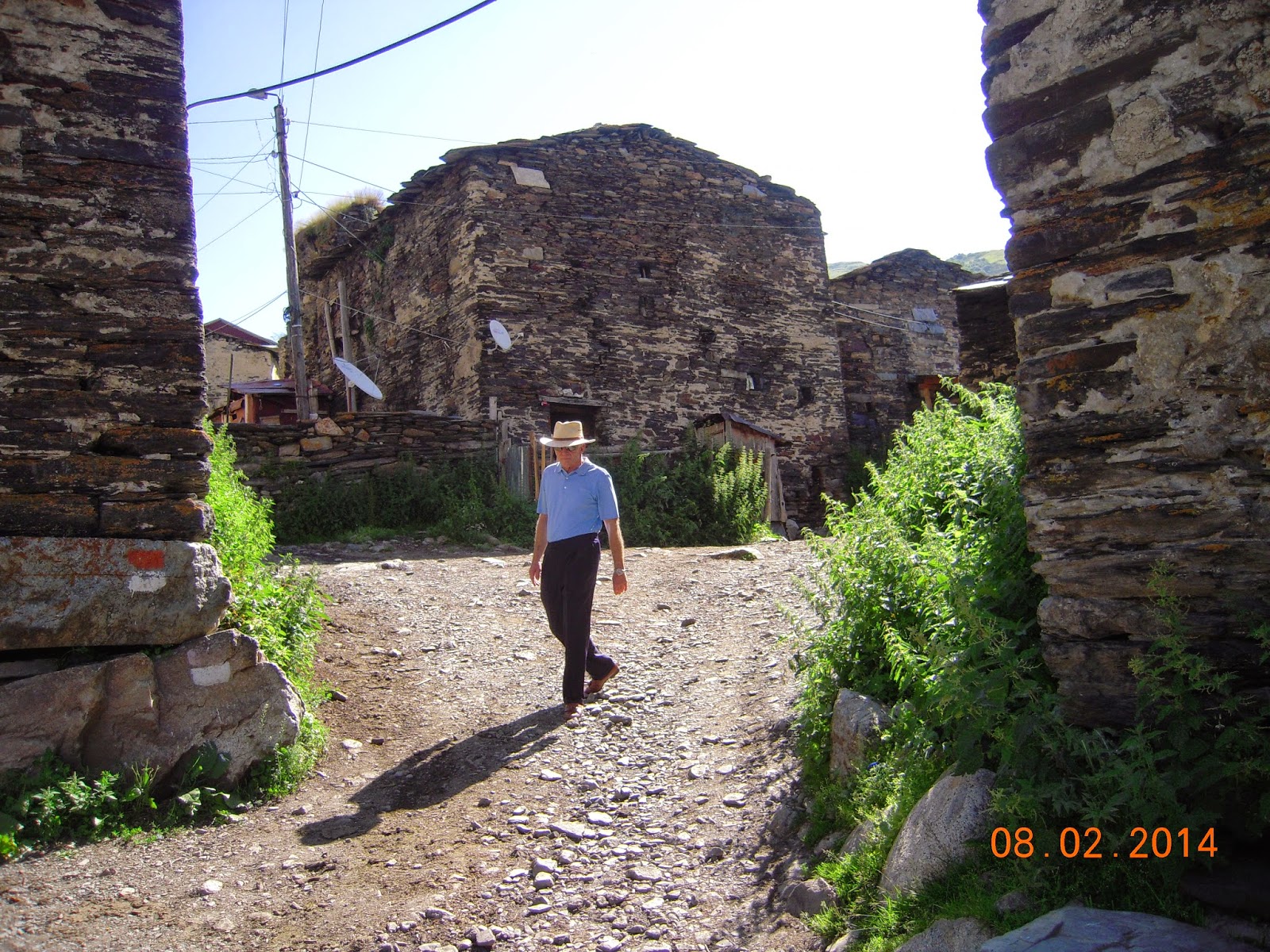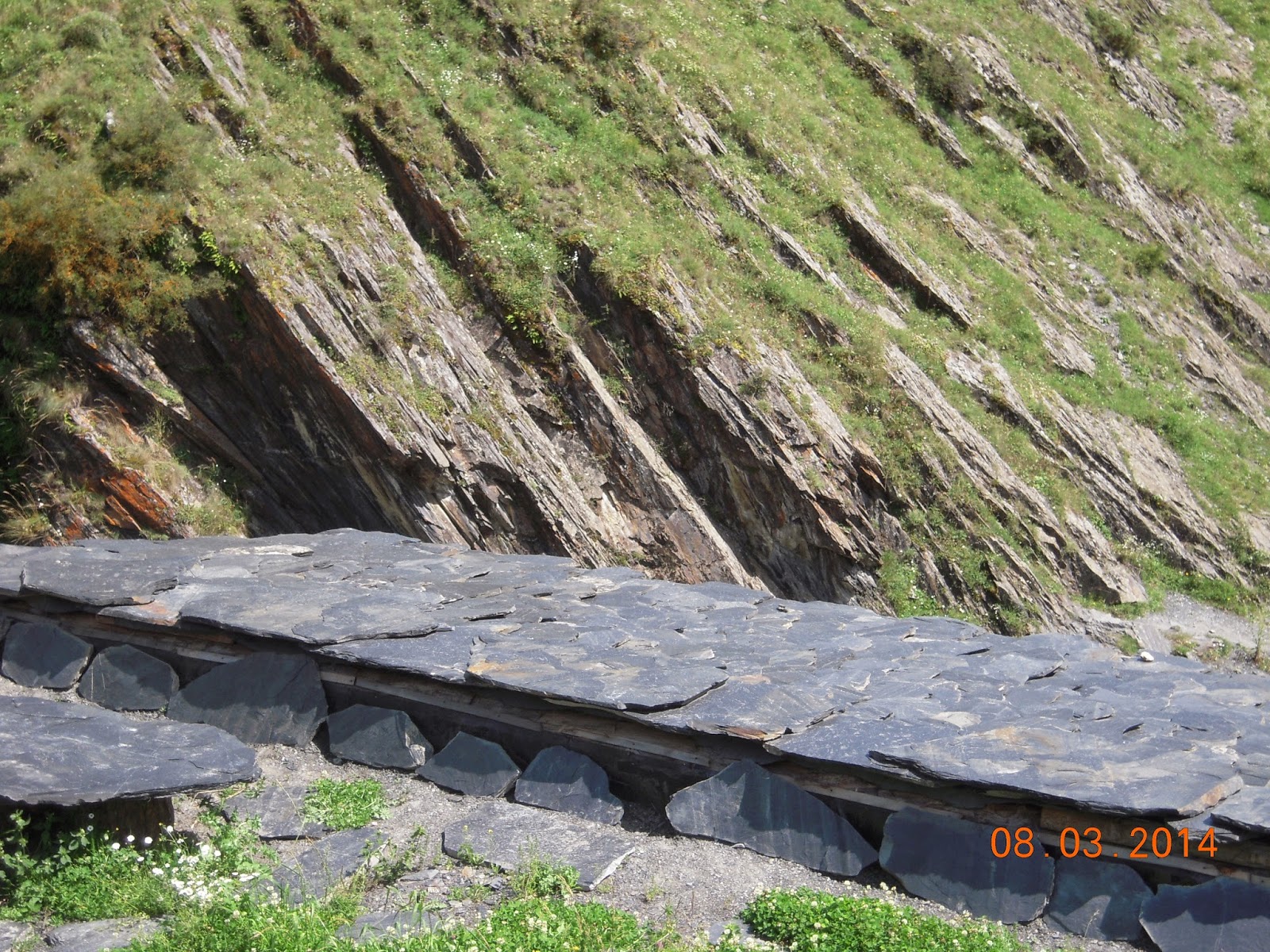Even though Frank and his family have been visiting Georgia for 20 years, he had never been to the Caucasus Mountains. When he looked into the logistics of that endeavor, he realized it would take us days to cover the amount of area he wanted to see. So, he rented a 20 person helicopter with a seasoned pilot to take us from village to village.
We took all of our bags to the local soccer field and waited in the sunshine for the thump thump of the rotor blades to reach us. Then we saw it weaving through the hills toward us.
The views from the helicopter were amazing.
The back of Ushba Peak.
Snow on the mountain tops in August.
Here we are inside the helicopter.
The first village we visited is the highest village (5400 feet) in the Caucasus Mountains that is occupied year round.
This church was built in the 10th century and is still in use today and lies just outside the village. We'll see the interior later.
These photos were taken just outside the landing area. John's children joined us for this part of the trip because the helicopter had to come from Tiblisi where the kids were.
Walking into the city was like walking back through time. Avoiding cow patties as well as rocks was a challenge. The buildings were almost as old as the church. The roads were rutted dirt with cows laying in the shade.
Breakfast was at the bed and breakfast of the local border patrol. He was the tacit leader of the community who knew John from his visits to the area to find polyphonic singers.
Just across from his establishment, which had the only indoor plumbing in the village, was another small chapel. That day, a Sunday, was the celebration of the village's patron saint.
Even though the religion is Georgian Orthodox, the people of the mountains retained many of their pagan rituals. On this day they were sacrificing a cow in honor of their saint to be shared communally. The priest blessed the cow and we came upon the scene just after the sacrifice as the men of the community were butchering it for the open fire on which it would be cooked.
It was quite an honor to be invited to the village on this special day and our host spent a great deal of time with us. Before we sat down to a breakfast much like the meals we enjoyed the day before, the border patrol man and the helicopter pilot asked the priest to bless their becoming blood brothers. By blood brothers I mean it literally; cut yourself and mix it with the blood from the cut of your brother. Not something anyone in the Western world would consider doing given the blood borne diseases in the world.
The toasts began as soon as our host joined us. At first we thought he was drinking water. But no, it was the local ChaCha. . .talk about strong . . .whew. And it was barely 10 am.
This is our host. He had the largest hands I have ever seen on anyone. Again the women did not dine with us. But they were gracious and thankful for our appreciation at the end of the meal. You see here the first course. Someone brought us pieces of the sacrificed cow to taste. By the time we finished the table was covered with plates.
On the way back to the helicopter, we stopped at the church. Women entering the church grounds were required to wear something over their heads and a skirt. I had the scarf and put it on immediately when we entered. Our host looked at me, put his big hand on my shoulder and thanked me. It was a precious moment for me.
The bells to call the people to worship.
A plaque over the entrance to the church with the Virgin Mary and Jesus.
Some of the icons inside the church.
Frescoes.
The altar.
The cemetery outside the church.
As we were leaving another couple entered the grounds. The woman was in shorts and was smoking a cigarette. Our host frowned and shooed them out with his big hands flapping, saying, "No, no, no." I'm not sure what nationality they were but they definitely understood him.
This skull was laying in the grass next to the helicopter.
For some reason, we had to divert back to Tiblisi to get additional gas for the helicopter. We loaded on several new packages and a couple of people we did not know.
Later we discovered that the helicopter pilot's son lived in a village close to the next village we would visit.
I needed to use the restroom, so while they fueled the helicopter, Jon and I walked over to the military building by the helicopter pad to use their facilities. Hadn't seen a toilet like this since Xian in China.
Back in the helicopter, our pilot took us deep between the mountains, banking left and right up a stream to the next village.
Past more abandoned towers.
And into the final village. This village was built in the 10th century as well and is only occupied in the summer. The houses are made of dry stacked stones with slate roofs.
This is the roof of the restaurant we ate in. This town has more visitors than the last. Check Republic hikers cross the Caucasus Mountains nearby and come to eat at this "hotel". It had indoor plumbing and you'll notice a satellite dish on the roof in one photo. They get their electricity from generators.
Underneath this slate roof was a quaint restaurant. Again, we were served copious quantities of food and offered local beer (yuck! reminded me of the Zulu beer we tried in South Africa - also yuck!). The thyme tea was delicious however. No pork is allowed in town which was a carry-over from Jewish beliefs in ancient times. They are sheep herders and in the "old days" the women and children would only come up to the village in the summer while the men stayed there with their flocks. We saw several flocks from the helicopter as we flew up the valley. (I should also mention that we passed a place where he water runs uphill.)
One of the people we picked up in Tiblisi was a young woman named Ecka. She is from this town but is now a US citizen and graduate of Berkley and serves as an Eco-tour guide in these mountains.
Horses are the main form of transportation in this area. There are 15,000 horses and 8,000 people.
Here a man and his son were getting ready to cross the stream. A colt followed with heels kicking up all the way.
These are small versions of the pots that John uses to age his wine. His are much larger and buried in the ground.
As the helicopter landed to pick us up, all the children ran down to see it up close. I wish I'd had little gifts to give them all to remember our visit.
This was the end of our excellent adventure, or so we thought. But the helicopter pilot had two more gifts for us. First he flew us, illegally, over the border of Tajikistan but the pilot wasn't worried. He leaned out the window and waved at his friends in the border guards as we flew over.
Then for a grand finale he landed in a field on the top of a hill, his favorite spot in the world. With the exception of the wild horses and a cow or 100, I doubt this particular area had been walked by very many humans. The ground cover was so thick that your feet sunk in to the ankle.
The panoramic views were humbling.
This was taken right after the obligatory ChaCha toast to our wonderful adventure.
As Tiblisi came back in sight, I was reminded of Frank's other saying. (Terribly paraphrased here.) He defined a rich man as one who has had amazing experiences and then gets to share them with his friends. I certainly felt rich and blessed then and now as I share this with all of you.
Thanks Frank for a most excellent adventure!


































































